外研版高一英语Unit 4 body language(reading)公开课课件(共18张)
文档属性
| 名称 | 外研版高一英语Unit 4 body language(reading)公开课课件(共18张) |  | |
| 格式 | zip | ||
| 文件大小 | 2.1MB | ||
| 资源类型 | 教案 | ||
| 版本资源 | 人教版(新课程标准) | ||
| 科目 | 英语 | ||
| 更新时间 | 2020-02-14 20:14:54 | ||
图片预览

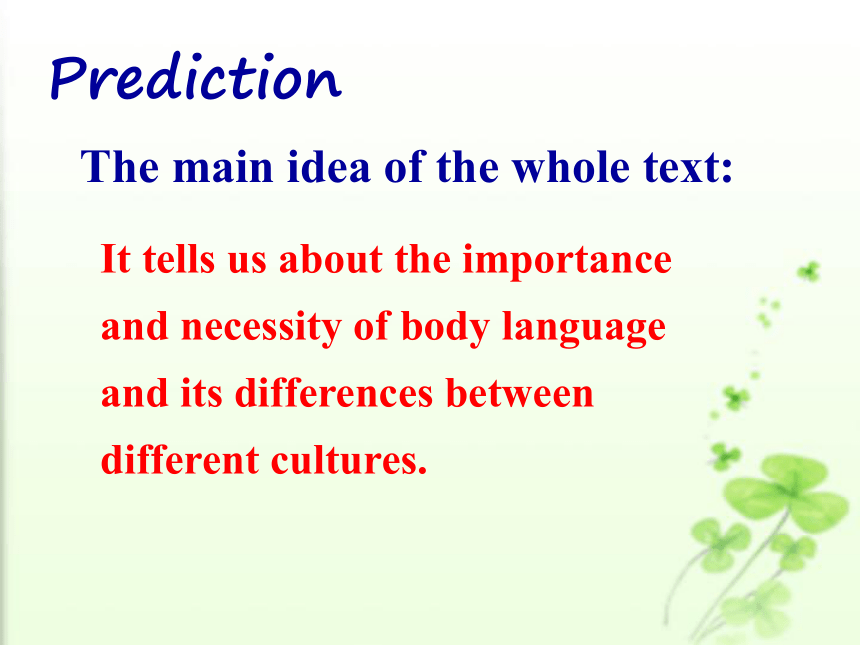
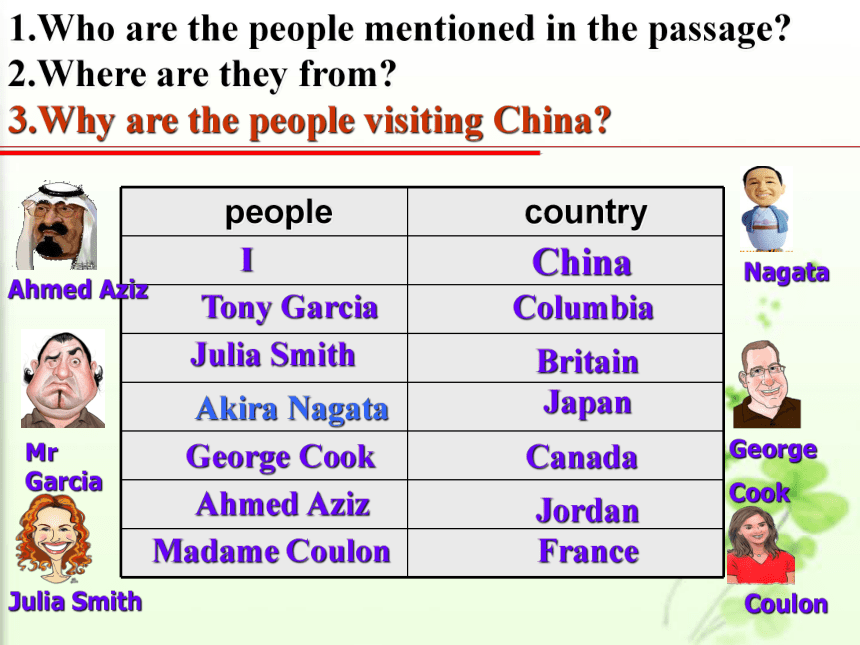

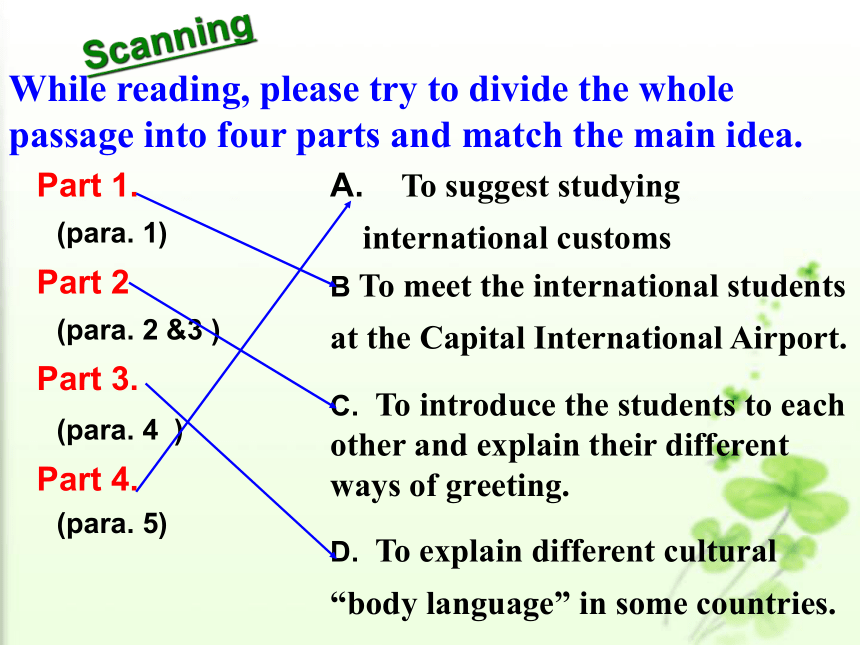
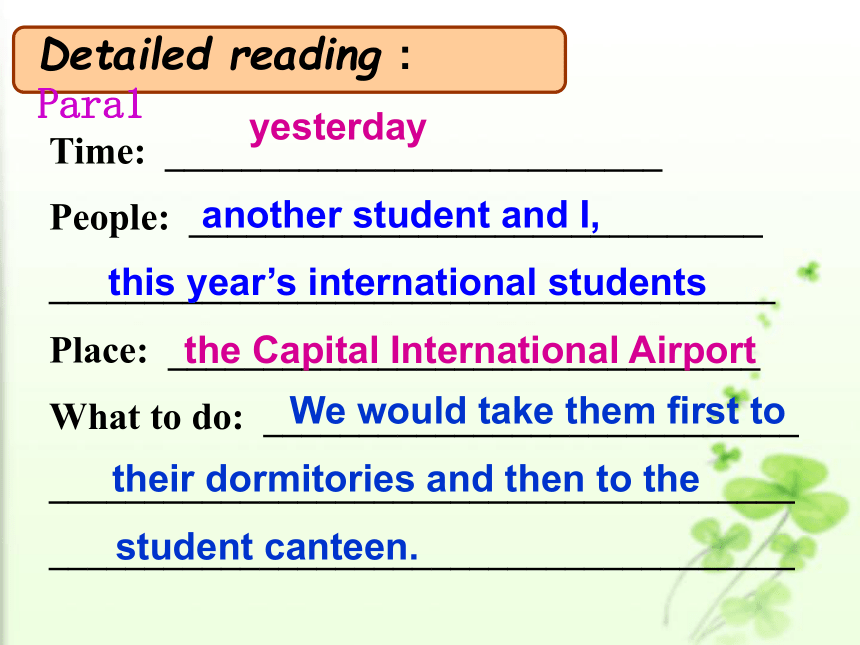
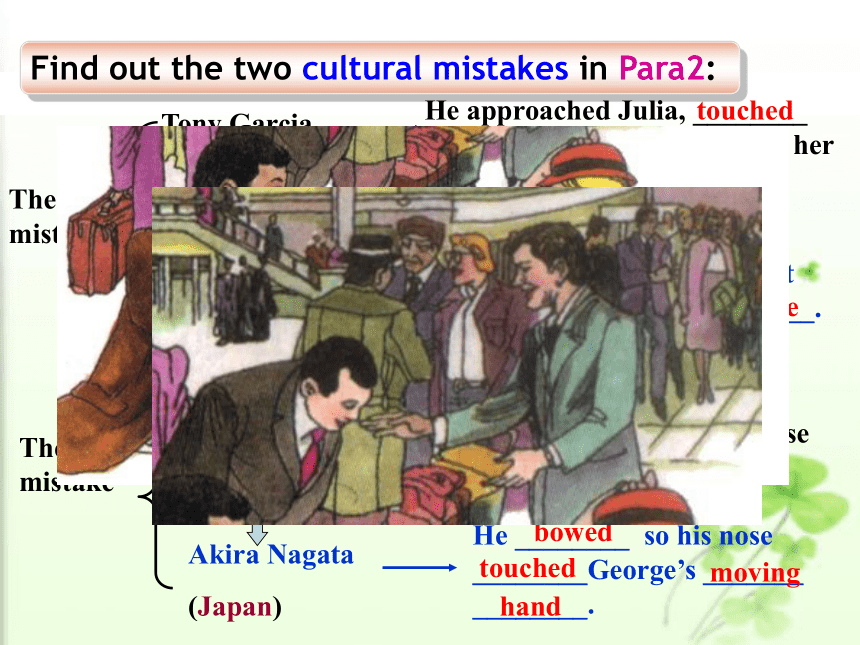
文档简介
(共18张PPT)
Reading
COMMUNICATION: NO PROBLEM?
It tells us about the importance
and necessity of body language
and its differences between
different cultures.
The main idea of the whole text:
Prediction
1.Who are the people mentioned in the passage?
2.Where are they from?
3.Why are the people visiting China?
China
Tony Garcia
Columbia
Julia Smith
Britain
Akira Nagata
Japan
George Cook
Canada
Ahmed Aziz
Jordan
Madame Coulon
France
I
people country
The text is mainly about different __________________ in different countries. In order to avoid difficulties in today’s world of cultural crossroads, we had better _________________________.
body language
study international customs
While reading, please try to divide the whole
passage into four parts and match the main idea.
Part 1.
(para. 1)
Part 2
(para. 2 &3 )
Part 3.
(para. 4 )
Part 4.
(para. 5)
D. To explain different cultural “body language” in some countries.
A. To suggest studying international customs
B To meet the international students at the Capital International Airport.
C. To introduce the students to each other and explain their different ways of greeting.
Scanning
Detailed reading : Para1
Time: __________________________
People: ______________________________
______________________________________
Place: _______________________________
What to do: ____________________________
_______________________________________
_______________________________________
yesterday
another student and I,
the Capital International Airport
this year’s international students
We would take them first to
their dormitories and then to the
student canteen.
Find out the two cultural mistakes in Para2:
Tony Garcia
Julia Smith
The first mistake
(Columbia )
(Britain)
He approached Julia, ________ _____ _________and _______ her on the ________.
She ______ ________ appearing _________ and put up her hands, as if ___ _______.
shoulder
touched
her
kissed
cheek
stepped back
surprised
in defence
The second mistake
Akira Nagata
(Japan)
George Cook
(Canada)
He ________ his hand ________ to the Japanese student.
He ________ so his nose ________George’s _______ ________.
bowed
touched
moving
hand
reached
out
How do men from Muslim countries greet others ?
2. How did Tony and Darlene greet each other?
Para3:
They shook hands and then kissed each other twice on each cheek, and this is the French custom when adults meet people they know.
To men:
To women:
stand close, and shake hands
nodding
3. Is the main character “I” male or female? How do you know?
Male. Because Ahmed Aziz only shakes hands with men.
_________others closely and are more likely to__________.
Do not stand _________to others or touch ________ when they meet.
Bow
Shake hands
Fill in the table according to Para4:
Read it together.
very close
strangers
Approach
touch them
People in the country/area Ways to greet each other
English people
People from Spain, Italy and South American countries
Japanese
Most people around the world
Para 5:
These _______ are not good or bad, but are _____ ways ____ _______ culture have developed.
Do all members of a culture behave in the same way?
In general, studying _____________ __________ can certainly help ______ ______________ in today’s world of cultural crossroads!
No, not all members of a culture behave in the same way.
international customs
avoid difficulties
actions
simply
in which
●Read the last paragraph and have a discussion : 1.What does the following sentence mean? None of these actions is either good or bad. 2. When in Rome, do as the Romes do.
Body language varies from culture to culture. Not all members of all cultures behave the same way. We should try to master and respect each other’s culture in order to make good communication.
1. When the Chinese meet, they shake hands. So do the Japanese.
2. The American like touching each other when they meet.
3. Englishmen often stand close to others or touch strangers as soon as they meet.
4. Most people around the world now greet each other by shaking hands .
Read the text carefully,
then decide if they are true (T) or false (F).
5.Not all cultures greet each other the same way, nor are they comfortable touching strangers or being too close or too far away.
6.People from Jordan will shake hands with a woman as she introduces herself to them.
7.Body language in some countries is good while some in others is bad.
8. French people usually shake hands and kiss each other twice on each cheek when they meet.
Fill in the blanks:
The first person to arrive was Tony Garcia from Columbia, closely _________ by Julia Smith from Britain. When they were introduced to each other, Tony approached Julia, _______ her shoulder and _______ her on the cheek . Julia stepped back appearing surprised. Akira Nagata
from Japan came in smiling at the same time with George Cook from Canada. As they were introduced, George _______ his hand out to the Japanese who ______ . His nose touched George’s moving hand, and they both _________ .
followed
touched
kissed
reached
bowed
apologized
These are examples of learned or cultural “body language”. Not all cultures ________ each other the same way, nor are they comfortable touching strangers or being too close or too far away. In the same way that people ____________ with spoken language, they also __________ their feelings using unspoken “language” through keeping physical distance, actions or _________.
express
communicate
greet
posture
Fill in the blanks:
Situation1: Mr. Garcia (Columbia, South America) meet Julia Smith (Britain, Europe)
Situation2: George Cook (Canada, North America) meet Japanese (East Asia)
Situation3: Chinese (East Asia) meet Ahmed Aziz (Jordan, West Asia)
Situation4: Madame Coulon (France, West Europe) meet Mr. Garcia (Columbia, South America )
Summary :
Body language differs from culture to culture. Not all members of all cultures behave the same way. We should try to grasp and respect each other’s culture in order to make good communication.
Reading
COMMUNICATION: NO PROBLEM?
It tells us about the importance
and necessity of body language
and its differences between
different cultures.
The main idea of the whole text:
Prediction
1.Who are the people mentioned in the passage?
2.Where are they from?
3.Why are the people visiting China?
China
Tony Garcia
Columbia
Julia Smith
Britain
Akira Nagata
Japan
George Cook
Canada
Ahmed Aziz
Jordan
Madame Coulon
France
I
people country
The text is mainly about different __________________ in different countries. In order to avoid difficulties in today’s world of cultural crossroads, we had better _________________________.
body language
study international customs
While reading, please try to divide the whole
passage into four parts and match the main idea.
Part 1.
(para. 1)
Part 2
(para. 2 &3 )
Part 3.
(para. 4 )
Part 4.
(para. 5)
D. To explain different cultural “body language” in some countries.
A. To suggest studying international customs
B To meet the international students at the Capital International Airport.
C. To introduce the students to each other and explain their different ways of greeting.
Scanning
Detailed reading : Para1
Time: __________________________
People: ______________________________
______________________________________
Place: _______________________________
What to do: ____________________________
_______________________________________
_______________________________________
yesterday
another student and I,
the Capital International Airport
this year’s international students
We would take them first to
their dormitories and then to the
student canteen.
Find out the two cultural mistakes in Para2:
Tony Garcia
Julia Smith
The first mistake
(Columbia )
(Britain)
He approached Julia, ________ _____ _________and _______ her on the ________.
She ______ ________ appearing _________ and put up her hands, as if ___ _______.
shoulder
touched
her
kissed
cheek
stepped back
surprised
in defence
The second mistake
Akira Nagata
(Japan)
George Cook
(Canada)
He ________ his hand ________ to the Japanese student.
He ________ so his nose ________George’s _______ ________.
bowed
touched
moving
hand
reached
out
How do men from Muslim countries greet others ?
2. How did Tony and Darlene greet each other?
Para3:
They shook hands and then kissed each other twice on each cheek, and this is the French custom when adults meet people they know.
To men:
To women:
stand close, and shake hands
nodding
3. Is the main character “I” male or female? How do you know?
Male. Because Ahmed Aziz only shakes hands with men.
_________others closely and are more likely to__________.
Do not stand _________to others or touch ________ when they meet.
Bow
Shake hands
Fill in the table according to Para4:
Read it together.
very close
strangers
Approach
touch them
People in the country/area Ways to greet each other
English people
People from Spain, Italy and South American countries
Japanese
Most people around the world
Para 5:
These _______ are not good or bad, but are _____ ways ____ _______ culture have developed.
Do all members of a culture behave in the same way?
In general, studying _____________ __________ can certainly help ______ ______________ in today’s world of cultural crossroads!
No, not all members of a culture behave in the same way.
international customs
avoid difficulties
actions
simply
in which
●Read the last paragraph and have a discussion : 1.What does the following sentence mean? None of these actions is either good or bad. 2. When in Rome, do as the Romes do.
Body language varies from culture to culture. Not all members of all cultures behave the same way. We should try to master and respect each other’s culture in order to make good communication.
1. When the Chinese meet, they shake hands. So do the Japanese.
2. The American like touching each other when they meet.
3. Englishmen often stand close to others or touch strangers as soon as they meet.
4. Most people around the world now greet each other by shaking hands .
Read the text carefully,
then decide if they are true (T) or false (F).
5.Not all cultures greet each other the same way, nor are they comfortable touching strangers or being too close or too far away.
6.People from Jordan will shake hands with a woman as she introduces herself to them.
7.Body language in some countries is good while some in others is bad.
8. French people usually shake hands and kiss each other twice on each cheek when they meet.
Fill in the blanks:
The first person to arrive was Tony Garcia from Columbia, closely _________ by Julia Smith from Britain. When they were introduced to each other, Tony approached Julia, _______ her shoulder and _______ her on the cheek . Julia stepped back appearing surprised. Akira Nagata
from Japan came in smiling at the same time with George Cook from Canada. As they were introduced, George _______ his hand out to the Japanese who ______ . His nose touched George’s moving hand, and they both _________ .
followed
touched
kissed
reached
bowed
apologized
These are examples of learned or cultural “body language”. Not all cultures ________ each other the same way, nor are they comfortable touching strangers or being too close or too far away. In the same way that people ____________ with spoken language, they also __________ their feelings using unspoken “language” through keeping physical distance, actions or _________.
express
communicate
greet
posture
Fill in the blanks:
Situation1: Mr. Garcia (Columbia, South America) meet Julia Smith (Britain, Europe)
Situation2: George Cook (Canada, North America) meet Japanese (East Asia)
Situation3: Chinese (East Asia) meet Ahmed Aziz (Jordan, West Asia)
Situation4: Madame Coulon (France, West Europe) meet Mr. Garcia (Columbia, South America )
Summary :
Body language differs from culture to culture. Not all members of all cultures behave the same way. We should try to grasp and respect each other’s culture in order to make good communication.
同课章节目录
